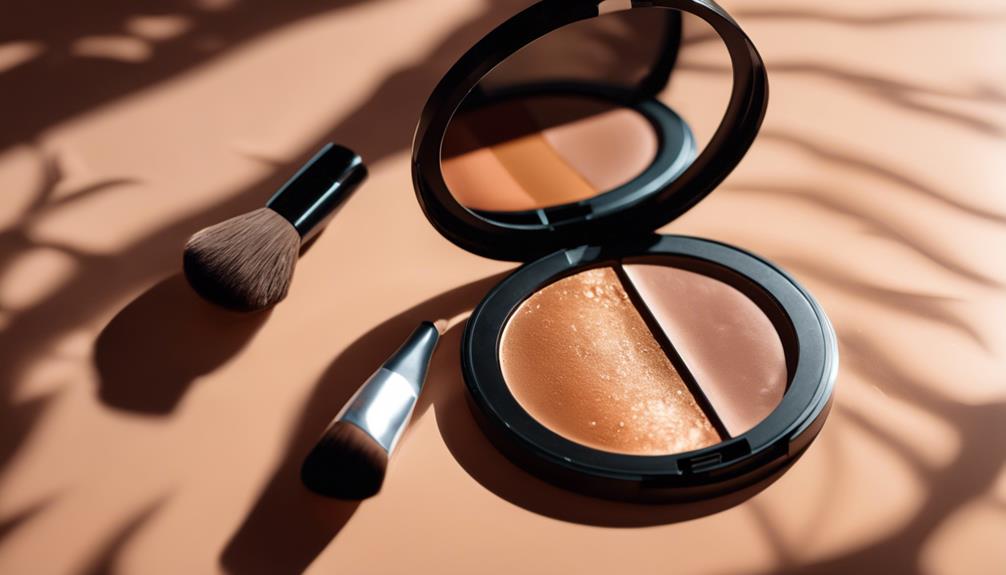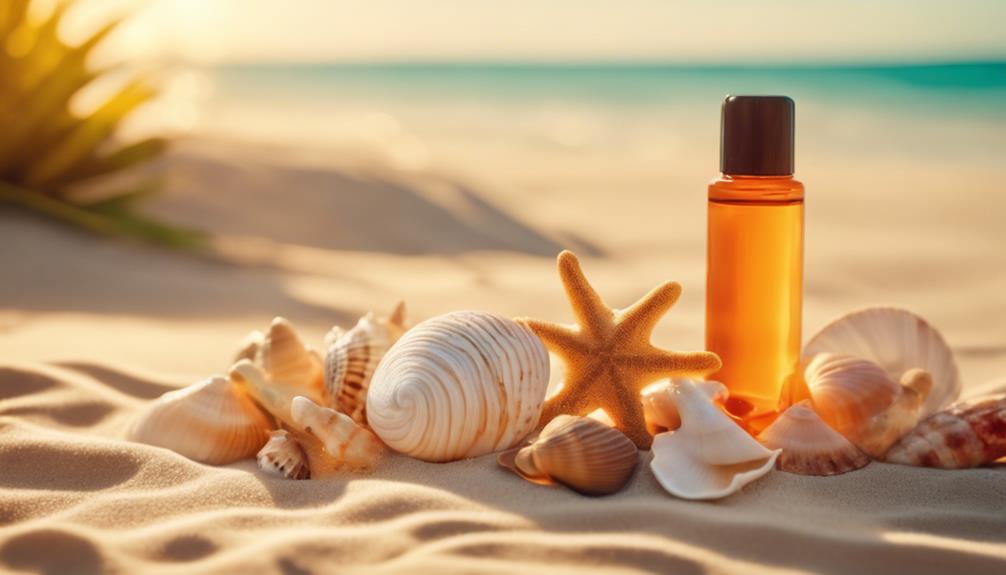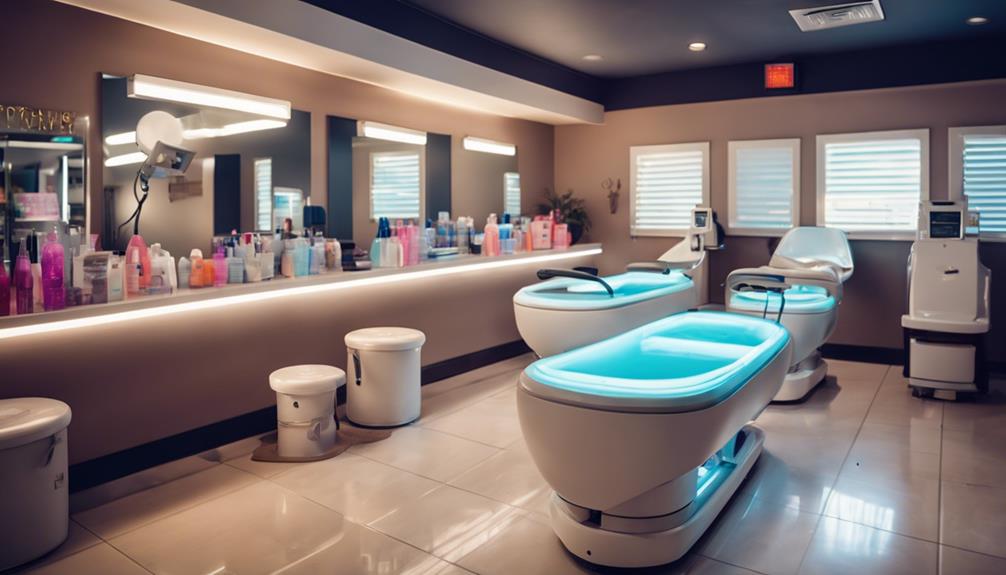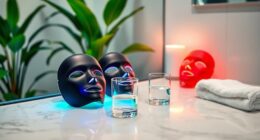To achieve a beautiful, healthy tan, start by understanding your skin type. Fair skin needs extra care, while olive tones may require more intense sessions. Keep your tanning sessions short at first, allowing 24 hours in between for recovery. Choose tanning beds suited to your skin's needs and always wear FDA-approved eye protection. Prepare your skin by exfoliating and using light moisturizers before tanning. After tanning, hydrate with non-oil-based moisturizers and avoid showers for at least 48 hours. Eating nutritious foods and staying hydrated will also boost your skin's health. There are more tips to help you glow safely!
Key Takeaways
- Identify your skin type to customize tanning sessions and minimize UV damage.
- Start with short tanning sessions, allowing 24 hours for skin recovery between each.
- Prepare your skin by exfoliating and using non-oil based lotions before tanning.
- Stay hydrated by drinking plenty of water to maintain skin moisture during tanning.
Understanding Your Skin Type
Before you start tanning, it's important to understand your skin type, as it directly influences how your skin reacts to UV exposure and helps you achieve the best results safely.
Assess whether your skin is fair, medium, or olive-toned, as each type has different sensitivities to UV radiation. Fair skin, for instance, burns easily, so you'll want to take extra precautions to avoid overexposure.
Knowing your skin tone allows you to customize your tanning sessions, ensuring you achieve that bronzed look without risking damage. Tailoring your approach based on your skin type is vital for a safe and effective tanning experience, helping you enjoy a beautiful tan while minimizing risks.
Personalized Tanning Frequency
Understanding your skin type sets the stage for determining how often you should tan, as a personalized approach can greatly enhance your results while minimizing risks.
Start with shorter sessions to see how your skin reacts, especially if you have fair skin, which may be more sensitive.
Allow at least 24 hours between sessions to give your skin time to recover.
Consulting with tanning professionals can help you create a customized schedule that suits your skin type.
Quality is more important than quantity; focus on achieving a healthy, even tan rather than rushing multiple sessions.
Choosing the Right Equipment
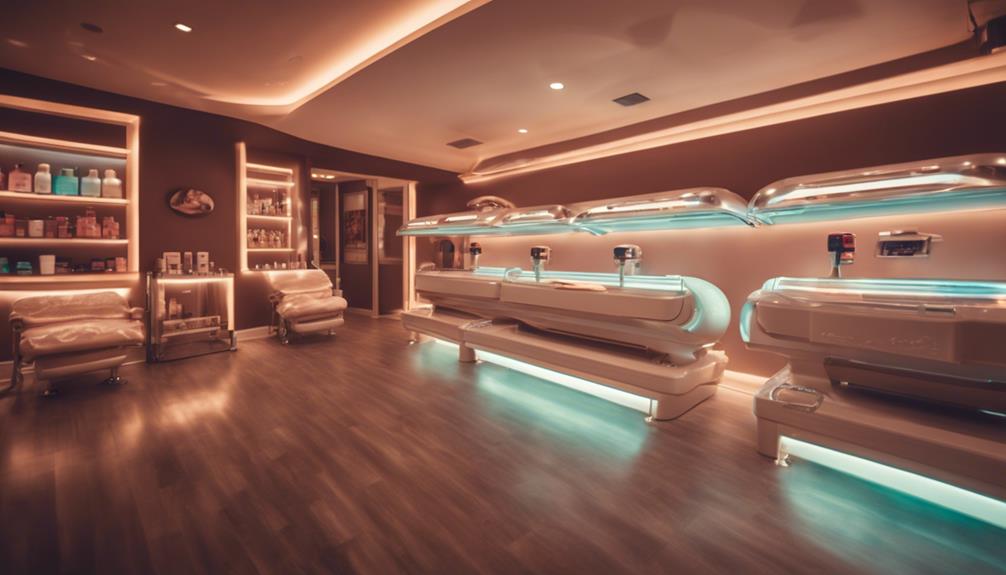
Selecting the right tanning bed and equipment tailored to your skin type is crucial for achieving ideal results while minimizing risks.
If you have fair skin, opt for beds with lower UVB rays to prevent burns. For olive skin, more intense beds may be necessary to achieve your desired tan.
Always prioritize your safety by using FDA-approved eye protection during your sessions.
Consult salon professionals to get recommended exposure times based on your specific skin type, and keep a close eye on how long you spend in the tanning bed.
Pre-Tan Preparation Essentials
Properly preparing your skin before tanning can greatly enhance your results and protect against damage.
Start by showering and exfoliating to remove dead skin cells, which helps guarantee an even tan. Avoid using oil-based products; instead, opt for non-oil indoor tanning lotions that promote a smooth application.
Hydrate your skin with light moisturizers before tanning, but skip SPF to maximize tanning effectiveness. Make certain to drink plenty of water, as hydration is key for healthy skin.
Don't forget to use protective eyewear and SPF lip balm to shield sensitive areas.
Finally, consider your skin type and choose a tanning bed that suits your needs for best results.
These essentials set the stage for a beautiful, bronzed glow.
Post-Tan Skincare Tips
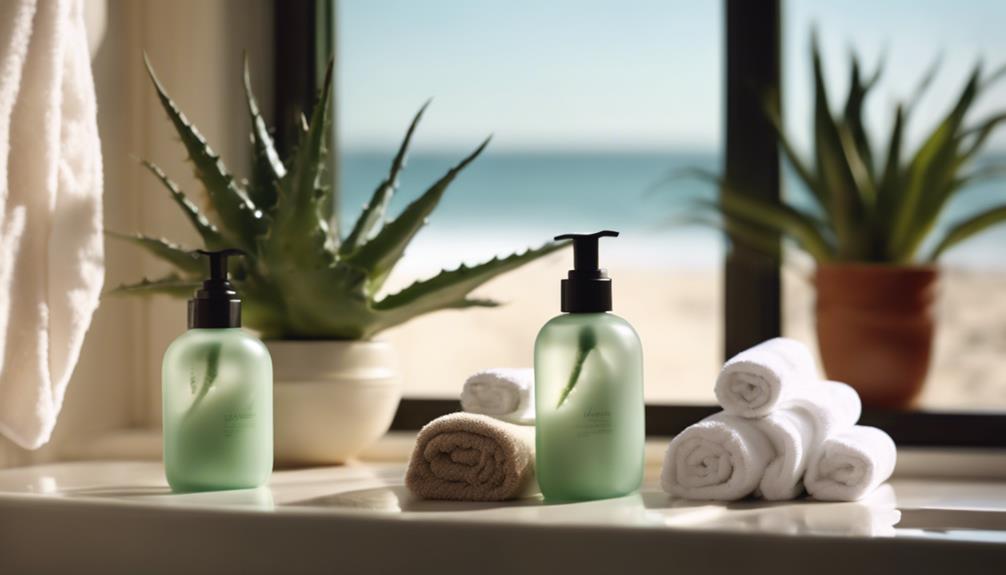
To keep your tan looking vibrant and last longer, focus on post-tan skincare by hydrating and moisturizing your skin effectively.
Start by using a non-oil based light moisturizer to lock in hydration.
It's important to wait at least 48 hours before showering to protect your tan.
When you do shower, keep it gentle and quick to avoid stripping away your color.
Instead of rubbing, pat your skin dry to maintain moisture.
Consistent moisturizing not only enhances melanin production but also helps your tan last.
Remember to drink plenty of water to support overall skin hydration.
Nutrition for Skin Health
Eating a nutrient-rich diet is essential for maintaining healthy skin and enhancing your tanning results. By fueling your body with the right foods, you can boost skin hydration and defend against UV damage.
Here are some key nutrients to include in your diet:
- Antioxidants: Found in berries and leafy greens, they combat free radicals from UV exposure.
- Healthy Fats: Avocados and nuts support skin elasticity and moisture retention.
- Citrus Fruits: High in vitamin C, they enhance melanin production for a safe, natural tan.
Incorporating these foods into your daily meals can greatly improve your skin's health and appearance.
Safe Tanning Practices

Understanding safe tanning practices is essential for protecting your skin while achieving a beautiful, bronzed look. Always assess your skin type to determine the best tanning approach. Use FDA-approved eye protection and consult salon professionals for recommended exposure times. Here's a quick reference guide:
| Tips | Recommendations |
|---|---|
| Skin Assessment | Identify your skin type first |
| Tanning Session Duration | Start with shorter sessions |
| Hydration | Drink plenty of water |
| Moisturizing | Use non-oil based lotion post-tan |
| Recovery Time | Wait 48 hours before showering |
Listen to your skin—if you feel discomfort, stop tanning immediately. By following these practices, you'll enjoy a safer tanning experience while keeping your skin healthy.
Frequently Asked Questions
How Can I Tell if My Tanning Bed Is Safe?
To determine if your tanning bed's safe, check for FDA approval, guarantee it's regularly maintained, and confirm the salon uses proper sterilization practices. Always ask professionals about the bed's UV output and recommended exposure times.
Are There Any Alternatives to Tanning Beds?
If you're looking for a healthier glow like Mia, who achieved a sun-kissed look with self-tanning mousse, consider alternatives like spray tans or bronzing lotions. They offer instant color without the UV exposure of tanning beds.
Can I Tan if I Have Sensitive Skin?
If you have sensitive skin, you can still tan, but you should take extra precautions. Start with shorter sessions, choose a low-intensity tanning bed, and always listen to your skin's reactions to avoid irritation.
What Should I Do if I Get Burnt?
Imagine waking up with painful, reddened skin after a day in the sun. If you get burnt, immediately cool the area with aloe vera, hydrate, and avoid further sun exposure until it heals.
How Does Tanning Affect My Skin Long-Term?
Tanning can lead to long-term skin damage, increasing your risk of premature aging and skin cancer. It's essential to understand how UV exposure affects your skin and take precautions to protect your health.
Conclusion
To sum it up, embracing the sun-kissed look doesn't have to come at the expense of your skin's health.
By understanding your skin type, personalizing your tanning routine, and following essential prep and post-care tips, you can strike the perfect balance.
Remember, taking care of your skin is like planting a seed; with the right care, it'll flourish beautifully.
So, go ahead and glow with confidence, knowing you're prioritizing your skin while enjoying that radiant tan!

